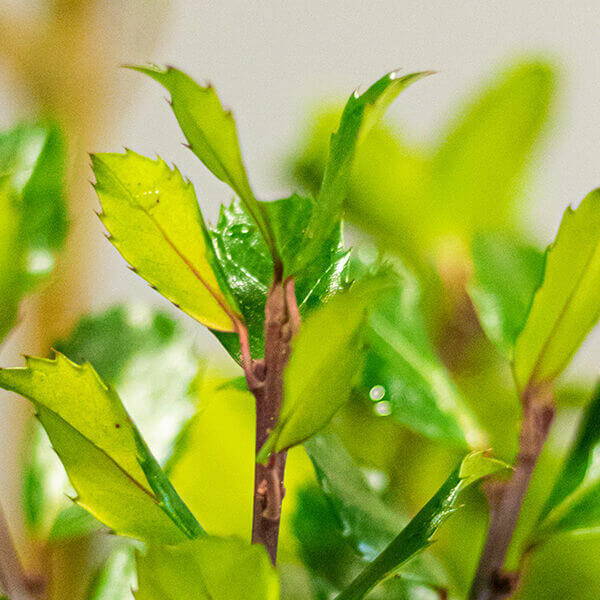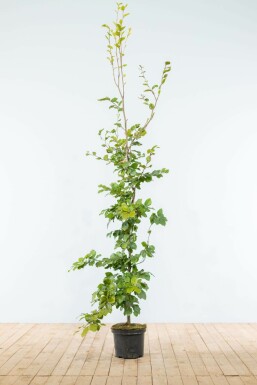Best Hedging Plants For Spring Flowers
Hardy Hedge Plants For Cold Climates
Enhance your garden's attraction with lavish hedge varieties such as Yew (Taxus), Thuja, Laurel, Photinia, and Bamboo, commemorated for their structural stability and ecological advantages.
Yew and Thuja provide evergreen coverage and winter season durability, while Laurel uses fast growth and broad, aromatic leaves.
Photinia includes seasonal appeal with its lively red foliage, and Bamboo provides a low-maintenance, peaceful atmosphere.
These hedges improve air quality, minimize noise, and produce tranquil, personal spaces.
Appropriate planting, spacing, and upkeep ensure vigorous development and environmental consistency.
Check out how these lush varieties can raise your garden's appeal and well-being.
Key Takeaways
Change Your Garden With Lush Hedge Ranges
- Select Yew for its dense, evergreen growth and unequaled longevity.
- Select Laurel for its quick development and broad leaves, guaranteeing quick personal privacy.
- Pick Photinia for its vibrant seasonal foliage, which turns a striking dark red.
- Utilize Bamboo for a low-maintenance, winter-hardy hedge with aesthetic appeal.
- Space plants 2-3 per meter and prune routinely for ideal development and health.
Popular Hedge Plants
When changing a garden with lavish hedge ranges, it's necessary to consider popular hedge plants such as Yew, Thuja, Laurel, and Photinia due to their special attributes and benefits.
Yew (Taxus) is highly esteemed for its longevity and dense, green growth, making it a prime choice for withstanding landscapes.
Thuja is kept in mind for its evergreen foliage and robust winter season strength.
Photinia includes seasonal vibrancy with red leaves that darken gradually, developing vibrant visual appeal.
Laurel uses fast development and aromatic, broad leaves, suitable for quick personal privacy.
In Addition, Bamboo is an exceptional choice for ambiance, providing a low-maintenance, winter-hardy choice that enhances the garden's aesthetic with its elegant, swaying walking canes.
These choices cater to a range of horticultural needs and choices.
Advantages of Garden Hedges
Garden hedges provide a wide range of benefits, making them an important addition to any landscape. These natural barriers are economical to execute and offer considerable wind protection, enhancing air blood circulation and adding to noise decrease. The dense foliage of hedges like Thuja and Beech guarantees privacy by blocking exposure, creating a remote and peaceful environment.
Hedges also play an essential function in microclimate policy, supplying a stable environment that fosters plant development and decreases temperature fluctuations. Their complex leaf structures filter contaminants, improving air quality and contributing to a healthier garden environment.
Moreover, hedges excel in sound reduction, soaking up and deflecting sound waves to lower ambient sound levels. This dual functionality of supplying both visual and acoustic personal privacy enhances the general tranquility and aesthetic appeal of any garden.
Planting and Upkeep Tips
For a successful hedge, precise preparation of the planting location is essential. Guarantee the soil has correct pH and drainage to support strong root development.
Area the plants appropriately for the selected types. Water the hedge frequently during its preliminary development phase, adjusting as needed with seasonal modifications.
Carry out a systematic insect control and disease avoidance method, using chemical or organic treatments when needed. Frequently inspect for aphids, mites, and fungal infections.
Apply mulch to keep moisture and reduce weeds. Seasonal pruning promotes thick development and air blood circulation, important for plant health.
Following these guidelines will help you cultivate a vibrant, properly maintained hedge that improves the beauty of your garden.
Spacing and Cutting Guidelines
Spacing and Cutting Standards
Correct spacing and trimming are vital for cultivating healthy, aesthetically appealing hedges. Adequate spacing ensures each plant receives sufficient nutrients, light, and airflow.
Follow these guidelines for ideal hedge upkeep:
- Spacing: Position hedge plants 2-3 plants per meter to motivate robust development.
- Pruning Techniques: Regular pruning is necessary for preserving wanted hedge height and shape. Trim new development in summertime and cut down older wood throughout winter season.
- Seasonal Care: Change cutting schedules and methods according to seasonal requirements to make sure plant health.
- Hedge Height: Routinely display and trim to keep the wanted hedge height and achieve uniform visual appeals.
Adhering to these steps will ensure your hedge thrives, boosting both the appeal and performance of your garden.
Selecting the Right Hedge
Choosing the Right Hedge
Selecting the proper hedge includes assessing elements such as fully grown height, foliage density, and ecological resilience. Effective hedge plant choice requires comprehending each species' development attributes and site-specific versatility.
For example, Yew (Taxus) uses outstanding longevity and thick development, while Thuja is notable for its winter season durability. Additionally, thinking about maintenance requirements is important; fast-growing types like Laurel or Privet need regular trimming, whereas low-maintenance alternatives like Bamboo or Ivy may be preferable for those looking for minimal upkeep.
Environmental factors such as soil type, light schedule, and wetness conditions ought to likewise direct the choice process. This cautious approach makes sure the selected hedges will grow, offering both functional and aesthetic advantages to the garden landscape.
Delivery and Planting Suggestions
To ensure your hedge plants prosper, they need to be provided by specialized couriers and planted immediately upon arrival.
Follow these necessary steps for effective planting:
- Soil Preparation: Improve the soil with raw material to improve drain and nutrient material.
- Planting Depth: Develop a trench twice the width and equal to the depth of the root ball.
- Watering Methods: Water completely after planting, keeping the soil regularly moist but not saturated.
- Mulching: Use a layer of mulch to maintain moisture and suppress weeds.
Consumer Assistance and Service
Given the essential role of timely support in horticultural pursuits, our consumer assistance group is available six days a week through telephone, email, and social media to provide professional advice and swiftly address any concerns. Their dedication to quick response times ensures customer fulfillment by solving questions related to plant health, optimal planting techniques, and maintenance schedules.

Action Time
-------------------
This extensive support group, enhanced by an excellent 9.3/ 10 customer score, highlights our dedication to boosting the gardening experience for every single customer.
Frequently Asked Questions
How Long Does It Take for Hedge Plants to Establish?
Hedge plants typically require one to three years to become fully established, with the exact duration varying by species and growing conditions.
Effective care throughout this important duration is necessary for robust development. Constant watering, alert weed control, and proper fertilizer application are essential in promoting strong root advancement.
For example, fast-growing species like Laurel may develop quicker, while slower-growing varieties such as Yew might take longer. Diligent maintenance speeds up the establishment process, resulting in healthy and thick hedges.
What Are the Finest Hedge Plants for Privacy?
The concern of the finest hedge plants for personal privacy involves evaluating evergreen and deciduous options.
Evergreen hedges like Thuja, Laurel, and Cypress supply year-round protection, ensuring constant privacy.
On hedging plants the other hand, deciduous hedges such as Beech provide seasonal privacy, shedding leaves in colder months.
Secret upkeep ideas for privacy hedges include routine cutting, fertilizing in spring, and proper spacing-- typically 2 to 3 plants per meter.
Furthermore, consistent watering and persistent weed removal are vital for promoting healthy, dense development.
Can Hedge Plants Attract Wildlife to My Garden?
Yes, hedge plants can draw in wildlife to your garden by supplying important advantages like shelter, food, and nesting sites, thereby improving local biodiversity. For circumstances, yew, holly, and laurel are outstanding for attracting birds, while ivy supports a range of insects.
However, it's crucial to note that there are some downsides, such as increased upkeep to manage bugs and routine upkeep. Carefully choosing and preserving hedge ranges can assist stabilize these disadvantages and advantages, eventually cultivating a sustainable and dynamic environment in your garden.
Are There Any Blooming Hedge Plants Available?
Yes, there are flowering hedge plants available that can improve the appeal of your garden.
For example, Elaeagnus, also understood as Olive Willow, produces aromatic white flowers in the fall, including a touch of beauty.
Photinia, another popular option, showcases vibrant red leaves that mature into a rich green, creating a dynamic visual impact throughout the seasons.
To make sure these plants thrive, it's important to practice correct pruning strategies and seasonal maintenance, such as trimming new growth in the summertime and cutting down in the winter season.
These procedures will assist maintain the health and aesthetic appeal of your blooming hedges.
How Do I Avoid Bugs in My Hedge Plants?
To avoid pests in hedge plants, employ natural pest control techniques and preserve appropriate hedge care. Introduce useful bugs like ladybugs, which victimize damaging insects, to produce a well balanced environment.
Routinely inspect your hedges for signs of infestation and promptly remove any afflicted parts to prevent the spread. Make sure the health of your hedges by applying well balanced fertilizers and providing appropriate water.
Use mulching to retain soil wetness and proper spacing to minimize plant stress and promote robust growth. These practices jointly assist in minimizing insect concerns and preserving a healthy hedge.
Conclusion
In essence, picking the right hedge ranges such as Yew, Thuja, and Laurel can change any garden into a peaceful sanctuary. These plants provide year-round greenery, boost aesthetic appeal, and offer useful benefits like sound reduction and wind defense.
Appropriate planting strategies, accurate spacing, consistent watering, and seasonal cutting are vital for ideal development.
Dependable shipment services and skilled client support guarantee a seamless experience from purchase to planting, making it easier than ever to elevate your outside space.
Garden hedges use a wide variety of benefits, making them an important addition to any landscape. These natural barriers are cost-efficient to execute and supply considerable wind protection, enhancing air blood circulation and contributing to noise decrease. The dense foliage of hedges like Thuja and Beech makes sure privacy by blocking visibility, developing a peaceful and remote environment.

Pruning Methods: Regular pruning is important for maintaining wanted hedge height and shape. Trim new development in summertime and cut back older wood during winter season.